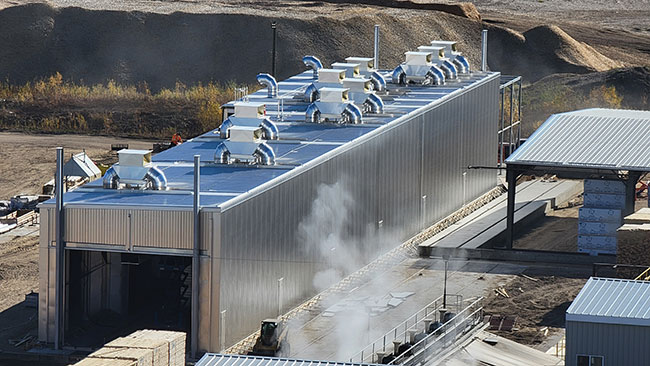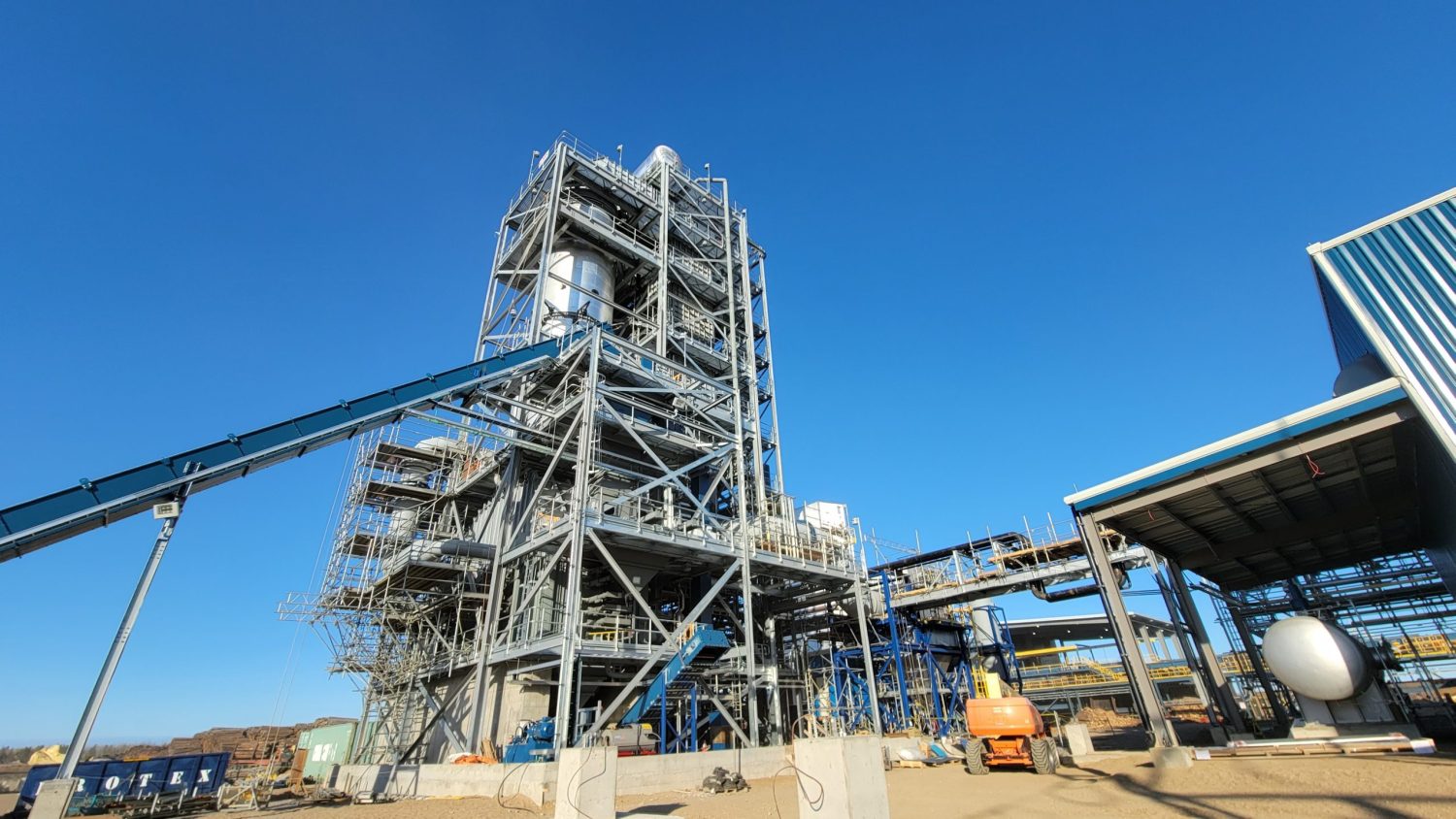
Features
Mills
Sawmilling
Sustainable drying: NorSask’s new continuous kiln to run off sawmill residuals
December 16, 2021 By Ellen Cools
 A new Muhlbock continuous kiln is being installed at NorSask Forest Products. Photo courtesy MLTC.
A new Muhlbock continuous kiln is being installed at NorSask Forest Products. Photo courtesy MLTC.
In the past few years, Saskatchewan’s forestry and bioenergy industries have seen a big boost, with multiple new investments announced and projects underway. One such project is the Meadow Lake Tribal Council (MLTC)’s new Bioenergy Centre in Meadow Lake, Sask., which is currently under construction.
The Bioenergy Centre will use residual wood waste from nearby NorSask Forest Products (also owned by the MLTC), to provide enough electricity to power 5,000 homes in the community. As part of that project, a new Muhlbock six-zone Progressive Flo 1306 PRO continuous kiln is being installed, which will run off of the energy produced in the Bioenergy Centre.
Repurposing residual waste
The MLTC (which is made up of nine First Nations communities) has owned NorSask Forest Products for over 30 years – 10 years as joint owners (1988 to 1998), and 20 years (1999 to 2021) as the sole owners.
The objective of MLTC’s bioenergy project is to generate carbon-neutral green power using sawmill biomass residuals and to reduce air emissions by eliminating one of Canada’s last remaining beehive burners.
“All of the wood waste coming out of the NorSask mill – trim-ends, sawdust, planer shavings, bark and off-sized chips – have been disposed of in a 50-year-old beehive burner, until now when a new technology is being brought into operation,” explains Tina Rasmussen, corporate development and administration officer with MLTC Industrial Investments.
MLTC’s elders and leadership have long understood that there needed to be something done with that biomass, to ensure that each piece of the tree is being used and not wasted, she adds.
“The bioenergy plant will enhance the economic outcomes of the nine First Nation communities associated with the Meadow Lake Tribal Council through improved operations of Canada’s only 100 per cent Indigenous-owned sawmill and by converting a waste stream into valuable energy that can be sold to SaskPower to power up to 5,000 Saskatchewan homes. The revenue produced by the sale of power created by the bioenergy facility will go directly back to support the First Nations communities,” Rasmussen explains.

Construction is currently underway at the MLTC Bioenergy Centre, which is expected to be fully operational by January 2022. Photo courtesy MLTC.
Management and leadership began the lengthy process of negotiating a power purchase agreement with SaskPower for the sale of electricity and secured a federal green energy grant funding to begin construction on the Bioenergy Centre.
“The project consists of a reciprocating grate furnace with thermal oil heat exchangers, an 8.3 MW organic rankine cycle (ORC) turbo-generator and all associated fuel handling and environmental emission systems. In general terms, all of the residual wood waste products from NorSask are burned in the thermal oil furnace,” Rasmussen explains. “The thermal oil plant combustion creates heat, which is transferred to an oil that in turn heats Cyclopentane, which becomes a gas. This gas then turns a turbine that produces electrical energy.”
Construction began on the Bioenergy Centre in April 2020, and will be fully operational in January 2022. The facility is capable of producing 8.3 megawatts of energy, of which 6.6 megawatts will go into the SaskPower grid.
Environmental benefits
The excess energy from the Bioenergy Centre will be used to produce and heat glycol, which will be piped to a new Muhlbock continuous kiln over at the NorSask mill.
The kiln has radiant-type heating throughout it to control the temperature, Rasmussen explains. All told, it will cut 50-60 per cent of natural gas usage at the mill.
“The efficiency and productivity gains of this new continuous kiln will be very exciting,” adds Kelly Lehoux, general manager of NorSask Forest Products. “It lowers our input costs by not having to use natural gas as a heat source. The new continuous kiln uses a lower temperature for drying lumber compared to a traditional natural gas heated batch kiln. The new continuous kiln will substantially improve our lumber drying quality.
On top of the environmental benefits, the new kiln will help offset some capacity challenges at the mill.
NorSask Forest Products produces 150 mmbf annually, but in March this year, a fire took out two of the mill’s existing batch kilns, both of which were around 50 years old. Since then, the mill has been down 40 per cent in terms of drying capacity, Lehoux shares.
“So, this new kiln will pick up that volume and then some. We expect the new kiln to dry 90 million board feet annually, which would be approximately 60 per cent of our production,” he explains.
“It’s giving us a substantial boost in lumber drying capacity, so we’re happy about that,” he continues. “It’s been a little tough to be without two kilns for seven months or so now, but we’re getting through it. The new kiln is well on its way with the construction phase nearing completion.”
The construction process has been fairly smooth and has not disrupted the mill’s normal operations, Lehoux says. There have been some challenges and delays caused by COVID-19, he admits, but “we’re a creative group, we work well as a team and we discuss our challenges in order to find solutions.”
Commissioning of the kiln will happen in November or December, and it should be fully operational in January 2022, when the MLTC Bioenergy Centre comes online.
A unique design
The Muhlbock continuous kiln is not your average continuous kiln. Not only will it dry lumber using glycol instead of natural gas as a heat source, it also has a unique design.
Lumber does not flow through the kiln continuously as one would expect. Instead, the kiln acts like six batch kilns in one. There are six zones inside the kiln that advance together at certain stages of the lumber drying process, Lehoux explains.
This is a big reason why Muhlbock won the request for proposal (RFP) that the MLTC put out when they first started looking for a new kiln.
“We had four or five different vendors bid on this project, and it came down to a few different things. The amount of volume that we could dry in the kiln was a big factor and, of course, price is another consideration. How the design fit into our way of doing things, particularly the lumber transfer system – that was a big part of it,” Lehoux explains.
NorSask has an uncommon lumber transfer system. Rather than using mobile equipment to move the lumber, they use an electric transfer car, he says. Additionally, lumber at the mill flows from north to south, but the kilns are loaded at the south end of the mill site.
As a result, “we couldn’t have wood flowing in both directions, which is very typical of a continuous kiln,” Lehoux explains. “So, the transfer system and the existing mill infrastructure is a key point in the choice to go with Muhlbock.”
Once construction on the kiln is finished, NorSask will begin training their staff on the new equipment.
“We’re going to put a lot of effort into training our controls people, our electrical team, mechanical team and the new kiln operators on the operation of the kiln,” Lehoux says. There will be a lot of effort upfront on training, safety protocols etc. I think it’s like any other piece of new equipment – you have to just go through the process and make sure everybody understands what’s required.”
But, he expects that the training will be fairly straightforward.
‘A huge opportunity’
Looking ahead, the new Muhlbock kiln and the Bioenergy Centre will have a big impact on the MLTC’s forestry operations, not only by reducing their greenhouse gas emissions and boosting production capacity, but also because by providing economic opportunities to local First Nations people and companies.
“We have opportunities here for Indigenous people to participate in the overall forest industry. If you’re looking at economic reconciliation from an Indigenous perspective, that truly is an opportunity. And this bioenergy facility is just a completion of the circle, an addition to taking every resource that we have and turning it into an opportunity,” Rasmussen says.
Print this page